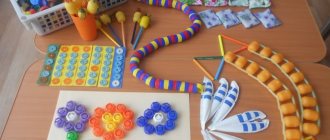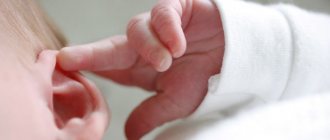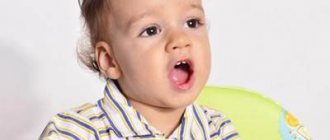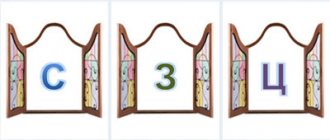Breathing is the energetic basis of spoken speech. The development of speech breathing largely determines the child’s formation of coherent speech, namely correct sound pronunciation, the ability to maintain normal speech volume, its smoothness and intonation expressiveness. By paying attention to establishing the correct speech breathing of the baby in early childhood, you can avoid many speech disorders in the future. In this article we will tell you about the features of speech breathing and ways of its development in preschool children.
Features of speech breathing in preschoolers
Speech breathing in preschool children differs from the breathing of adults and has its own characteristics:
- Insufficient development of the respiratory apparatus. If the inhalation and exhalation are weak, then the child’s speech will sound quiet and unintelligible. Sometimes, due to lack of air, children do not finish sentences. There are times when the baby tries to pronounce the entire phrase while inhaling, so he speaks quickly and does not observe logical pauses. Poor development of the respiratory system may be associated with the presence of chronic respiratory diseases in the child, such as sinusitis and sinusitis, as well as a sedentary lifestyle.
- Irrational distribution of exhaled air. Children who have recently learned to speak often run out of air on the first syllable, so they pronounce the end of a word or phrase much more quietly or even “swallow” it.
- Inability to distribute breathing according to words. To replenish the smell of the air, the child has to take a break, during which he may forget what he wanted to say.
- Speech sounds may be distorted due to improperly exhaled air.
Speech breathing in most preschool children is imperfect. But it is often difficult for parents to notice this due to the fact that they communicate with the baby constantly.
There are approximate norms for the number of words pronounced on exhalation, which can be used as a guide when assessing a baby’s speech breathing:
| Child's age | Number of words per exhale |
| 2-3 years | 2-3 words |
| 3-4 years | 3-5 words |
| 4-6 years | 4-6 words |
| 6-7 years | 5-7 words |
Results
Speech breathing is the force that sets in motion the mechanism of sound formation that makes speech sound.
Correct speech breathing allows you to pronounce sounds correctly, speak clearly and expressively fluently. You can try breathing exercises starting from the age of one year. Such games have a positive effect not only on speech development, but also, in general, on the child’s health. Breathing exercises help saturate the body with oxygen, stimulate the functioning of the heart, brain, and nervous system.
How to breathe correctly?
When diagnosing speech development, speech therapists always pay attention to how the child breathes during a conversation, the strength and duration of his inhalations and exhalations, and how he places pauses. Formation of speech breathing is one of the first stages of correctional work with a child who has any speech disorders. Correct speech breathing has the following signs:
- Short breath through the nose;
- Exhale smoothly, the air comes out through the mouth;
- Exhalation is carried out to the end;
- After each exhalation there should be a short pause (2-3 seconds).
The development of speech breathing is closely related to the functioning of physiological breathing.
| Physiological respiration | Speech breathing |
| Involuntary | free |
| Inhale - exhale - pause | Inhale - pause - exhale |
| Inhalation and exhalation are carried out in one impulse. | Inhalation is carried out with one impulse, exhalation - with several (depending on the content of the statement). |
Only by learning to breathe correctly (deep short inhalation and smooth long exhalation) will a child be able to fully master his voice. The most effective methods of working with preschoolers are breathing exercises. Conventionally, they can be divided into two large groups, depending on their purpose:
- Formation of correct exhalation;
- Breathing training using various speech materials (practicing the pronunciation of sounds and their combinations, learning poetry).
The development of speech breathing in preschoolers allows:
- Speed up the process of staging and automating speech sounds;
- Increase the number of words that the baby pronounces in one exhalation;
- Form intelligible, coherent speech;
- Coordinate the processes of speech, breathing and movements.
Air volleyball
At home there is often a lack of outdoor games. The neighbors downstairs are not very fond of football and jumping; the neighbors on the side are not happy about the ball hitting the wall. It’s a different matter than air volleyball, when you can pump up your breath and play to your heart’s content.
The rules are simple: you need to pass the balloon to each other without using your hands or feet. Just one breath. There is, of course, a risk that children will run around the room. But it's worth it.
If you really want the game to be quiet, offer to keep the balloon in the air for a while. Who can keep it on the weight longer? By the way, try to compete with children. It's not a fact that you will win.
Recommendations for performing breathing exercises
- Classes must be carried out in a well-ventilated area;
- All exercises should be performed before meals;
- Clothing should not hinder the baby's movements;
- The muscles of the child’s neck, shoulders, arms, chest and abdomen should be relaxed;
- Inhalation should occur through the nose;
- The exhalation should be long and smooth;
- Make sure that when performing breathing exercises, the child does not puff out his cheeks. At first, you can hold them with your palms;
- 3-5 repetitions of each exercise are enough, between which you should take a 2-3 second pause. The total duration of breathing exercises should not exceed 5 minutes.
It is very important to measure the amount of breathing exercises and perform them at a moderate pace to avoid hyperventilation.
Making foam
Children adore this entertainment, but, as practice shows, even schoolchildren enjoy this hooliganism.
You will need a large tray (or cover the table with oilcloth), 2-5 glasses or bowls of water. Better than transparent ones. Pour water into each, add a couple of drops of detergent and the magic ingredient - food coloring. The number of colors is limitless as you understand.
We arm the children with cocktail straws and start actively blowing. The colorful foam is an absolute delight for everyone.
By the way, you can draw with it. It is enough to roll out a roll of paper under all these glasses.
Exercises to develop the strength and duration of exhalation
- Breeze. Tie several ribbons of serpentine or Christmas tree rain to a thread or lace. Invite your baby to blow on them and create a breeze. You can make the task more difficult by asking them to blow on ribbons of a certain color. The distance between the face and the ribbons should be approximately 10-15 cm.
- Leaf fall. Cut out real autumn leaves from paper or collect them from the street. Together with your child, you can arrange a real leaf fall by blowing them off the table. In the winter season, you can also play with paper snowflakes.
- Fly, feather! Let the baby throw the feather up and blow on it from bottom to top, not letting it fall.
- Pencil athletes. Draw start and finish lines on the table. At the start, put two pencils of different colors. Take turns blowing with your child on his own pencil and arrange a competition to see which of them will “run” to the finish line first.
- Sailors. Make boats out of paper or cork and lower them into a basin of water. There is a strong wind at sea - we blow on the ships, forcing them to move.
- Blow out the candles. You can role-play a birthday situation with your child. Prepare a toy set, cake and real candles. By blowing out the candles, you can make a wish.
- Pinwheel. A fidget toy is great for creating proper exhalation. Children love to watch the rotating blades and are proud of the result of their efforts.
- Whistles with the sounds of various animals and birds will also delight the baby and will be very useful for the development of his speech breathing.
- Another simple way to practice breathing is using soap bubbles.
Make sure that the child makes smooth and long exhalations. Gradually make the exercises more difficult by increasing the distance between your face and the object being deflated.
Breathing games
To carry out these games you will need simple equipment: paper devices, whistle toys, balloons.
- Flying butterflies.
It is necessary to cut out several paper butterflies and tie them by a thread to a strong rope at a short distance from each other. Butterflies should be positioned at the level of the child's face. An adult shows him how to blow on butterflies so that they begin to “flutter”, and then asks him to repeat. It is important that the baby stands straight, does not raise his shoulders as he exhales, does not puff out his cheeks, does not suck in air, and pulls his lips forward a little.
- Rainbow bubbles.
The mother shows the child how to blow soap bubbles using a straw, a cocktail tube or a special frame that comes with the bubbles. Then the baby tries to repeat. He may have difficulties, so the task of adults is to support the baby and motivate him.
- Whistles.
You will need wooden, clay or plastic whistle toys. The child is asked to whistle to hear his bird or animal sing. This is a very exciting game for preschool children; they will “whistle” with pleasure.
- Magic breeze.
You need to prepare “trees” - panicles made of colored paper cut into strips and attached to a stick (you can use Christmas tree “rain” instead of paper). An adult shows the child a magic tree and offers to blow on it to hear a light magical breeze.
- Flying ball.
To play, you need an inflated balloon, which is hung at the level of the baby's face. The parent shows the child how to blow on the balloon to make it fly up. The little player must repeat the exercise. A more difficult option is that the ball is not tied, and the child’s task is to lift it up and hold it there, using only the force of exhalation.
Exercises to practice correct pronunciation of sounds and syllables
To teach your baby to correctly pronounce vowels and consonants, syllables and sound combinations, you need to train them to pronounce them in one exhalation. Invite your baby to sing “songs” that imitate various sounds:
- “Ahhh!” - the baby is crying;
- "Uh-oh!" - the plane is flying;
- “Y-y-y!” — the steamer is humming;
- “Oh-oh-oh,” the bunny sighs;
- “F-f-f” - the balloon deflates;
- “Sh-sh-sh” - the snake hisses;
- “Ssss” - the pump is running;
- “Beep!” - the car honks;
- “Too-too” - the locomotive is moving;
- “La-la-la” - the doll sings;
- “Top-top-top” - the bear goes;
- “Drip-drip-drip” - it’s raining.
To engage your child, create a playful situation using your child’s favorite toys in class. Reinforce your speech with appropriate actions, and let the baby repeat after you.
We play with what's at hand
To play, developing the power of exhalation, it is not necessary to use any equipment. There are games that are played “without anything”, or with objects that are always at hand.
- Let's sing!
During this game, the songs are a smooth stretching of different vowel sounds. First, the mother shows the child how to sing the sound A, then O, U, Y, I, E, etc. When the baby begins to produce rather long “songs,” you can invite him to combine them: a song can consist of a sequence of vowels: A-O-I, A-U-E, etc.
- The snowball has started!
To play, you will need small pieces of ordinary cotton wool, which is found in every home. They are laid out on the table, and the adult invites the child to imagine that winter has come and it is snowing. To do this, you need to blow on the “snowflakes” so that they fly off the table. In the group version of the game, children can compete, for example, whose snowflakes will fly off first, or whose snowflakes will fly farthest.
- Living pencils.
Colored pencils are laid out on the table (round ones are more convenient to start with, later you can use ribbed ones). The child’s task is to roll each pencil with the force of exhalation to the other end of the table. In a group version, children sit opposite and roll pencils to each other from one end to the other.
To the very edge
Children love to gurgle tea and cocoa and do not really like to wipe the table after these games. Great. Then we invite them to master gurgling skills to perfection.
Take two glasses, preferably transparent ones. Pour a lot of water (tea or juice) into one, and a little into the second. Task: gurgle for as long as possible, but so that the bubbles rise to the edge, but not a drop spills past.
Try it yourself: it's not that easy. The game will improve the skill of controlling the force of exhalation and its correct distribution.
Sea battle
If there are siblings in the house, then this is just the perfect bath time game. Actually, you need two participants (but more are possible), a container of water (a basin on the table is also suitable), a flotilla (you can use paper boats, or you can use Kinder surprise packages, providing them with a paper sail, for example).
So, the regatta begins. Whose boat will reach the finish line first? Here the breathing should be light and directed so that the boat does not capsize, strong so that it floats further than others and measured so that there is enough breathing to bring the ship to the finish line.
By analogy, you can arrange races of paper balls on the table, having previously marked it with tape. All family members should participate in the competition: who has the strongest breath?
Literature:
- Bolshakova S. E. Speech disorders and their overcoming: Collection of exercises. - M.: Creative Center Sphere, 2005.
- Identification and overcoming of speech disorders in preschool age: Methodological manual / Comp. I.Yu. Kondratenko. - M.: Iris-press, 2005.
- Krause E.N. Speech therapy massage and articulation gymnastics. Practical guide. - SPb.: CORONA-print, 2004.
- Leonova SV. Fun warm-up // Speech therapist. - 2004. - No. 6.
- Tsvintarny V.V. The joy of speaking correctly. - M.: Center-polygraph, 2002.
- T. A. Vorobyova, P. A. Vorobyova Breathing and speech: Working on breathing in a comprehensive technique for correcting sound pronunciation. - St. Petersburg: Litera Publishing House, 2014.
II. Practical part.
Games to develop diaphragmatic breathing.
“Inflate the balloon” Choose a comfortable position (sitting, standing), put one hand on your stomach, the other on the side, on the lower part of your chest. Take a deep breath through the nose (at the same time, the stomach protrudes slightly forward, and the lower part of the chest expands, which is controlled by one or the other hand). After inhaling, immediately take a free, smooth breath (the stomach and lower part of the chest return to their previous position).
Here we are inflating the balloon, And we check with our hands: The balloon bursts - we exhale, We relax our muscles.
“Pendulum” I.p. - sit cross-legged, hands on the back of your head. Take a calm breath - pause Zs. - bend forward - exhale, return to the starting position - inhale. Repeat 3-4 times.
“Hunting” Teachers close their eyes, the speech therapist puts an orange, an apple, a lemon, jam, and perfume in front of them. It is necessary to take a deep breath, with your eyes closed, and determine by smell what kind of object is in front of them.
“A hedgehog walks through the forest” Standing position, hands on the belt, feet shoulder-width apart. Inhale while simultaneously turning your head to the right and moving your right arm to the side. After exhaling and returning to the starting position, the exercise is performed with a turn to the left.
Games for developing speech breathing
After the preparatory period aimed at developing physiological breathing, one should gradually move on to the development of speech breathing itself.
Work on the development of speech breathing is carried out in the following sequence:
- without speech,
- based on vowel sounds,
- consonants,
- syllables, words,
- sentences, phrases.
We will focus on the first stage of work: the development of speech breathing without voice.
When starting to develop speech breathing in a child, it is necessary first of all to form a strong, smooth oral exhalation. At the same time, it is necessary to teach the child to control the exhalation time and use air sparingly.
• Exercises to develop oral exhalation. “Let’s blow on the turntables” or “Sultans”, “Snowflakes”, “Let’s blow on the leaves”. Similarly, children blow on flowers, butterflies, birds, Christmas trees, etc. “Push the ball into the goal,” “The fastest pencil,” “Hot tea,” “Soap bubbles.”
Games with water: “Funny Bubbles”, “Boat”, etc.
• Exercises aimed at strengthening central exhalation. “Let’s blow on your finger”, “Let’s blow into a bottle”, “Focus”, etc.






